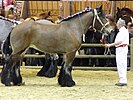The Trait du Nord is a breed of heavy draft horse developed in the area of Hainaut in western Belgium and in northeastern France. Originating in the fertile Flemish grasslands, it was bred for size and pulling power for agricultural work. Horses of the breed are considered to be gentle and easy to handle. They have many colors, although bay and roan are the most common. Originally considered a subtype of the Ardennes horse, it was recognized as an individual breed with the opening of a studbook in 1903. The Trait du Nord was used extensively in mining from the late 19th century through 1920 (and occasionally through the 1960s), and in agriculture through World War II. During the mid-20th century, the breed was in demand for the production of horse meat, but this demand began to decline by the early 1970s, and the Trait du Nord, like many European draft breeds, was in danger of extinction. In the 1990s the breed experienced a slight revival through an increased interest in recreational riding and driving, but it is still considered to be endangered by the French government, with a high risk of inbreeding: there are fewer than 100 new foal births a year. The national breed registry in France is working with local groups to reverse the decline. (Full article...)
Recently featured: Jesus nahm zu sich die Zwölfe, BWV 22 – Female genital mutilation – Marcus Ward Lyon, Jr.
